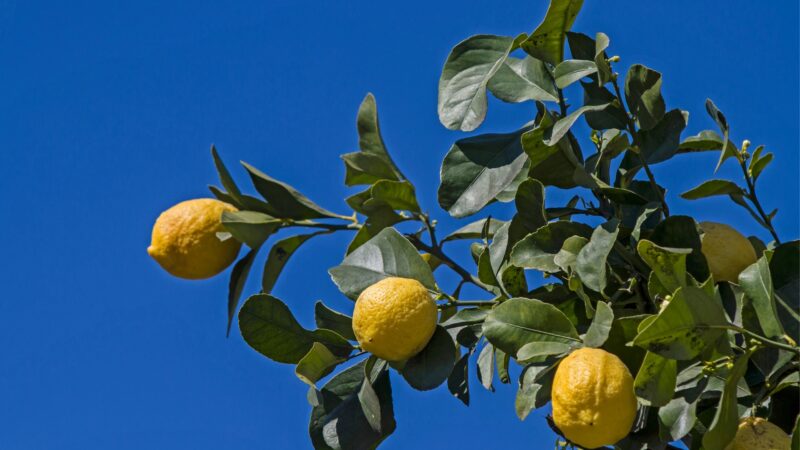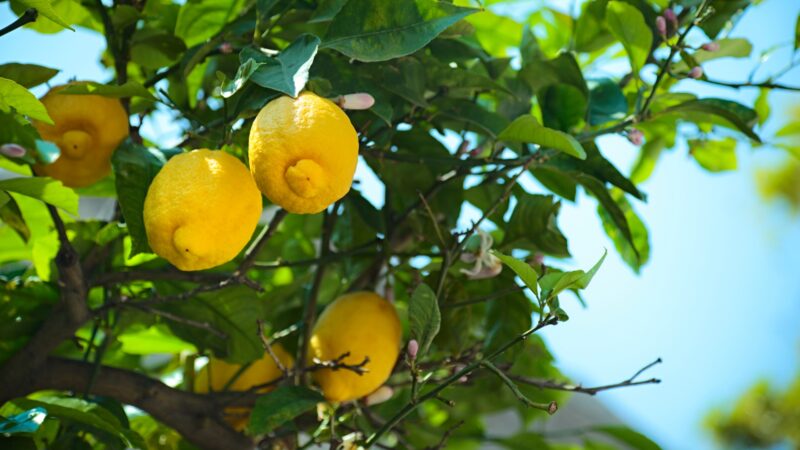Lemon trees are a popular choice for most gardens. Aside from being low maintenance, they also add a unique charm thanks to their glossy green foliage.
And the fact that you get lemons from them is a bonus. But with that said, have you seen a lemon tree with curling leaves? If you have, know that this is a cause for concern.
The following are the 7 causes of curling lemon tree leaves:
- It is experiencing drought stress.
- It is overwatered.
- It is underwatered.
- It has been exposed to extreme temperatures.
- It is suffering from nutrient deficiencies.
- It has lemon tree disease.
- It is suffering from a pest infestation.
To be able to give your lemon tree the best care, you should be familiar with these seven causes, as well as their corresponding remedies. Fortunately for you, that’s what this article will teach you.
As you read on, you’ll learn how to identify the specific cause for the leaf curling, its accompanying symptoms, and how to take care of your lemon tree when in that particular situation.
What Do Lemon Tree Leaves Curling Look Like?

A healthy lemon tree will have glossy forest green-colored leaves. These leaves are usually flat, so you can easily observe their ovate or oblong shape with a pointed tip.
In contrast, when lemon trees are unhealthy, their leaves curl inwards starting from the sides. The reason for these leaves’ curling may be due to several reasons, including drought stress, overwatering, underwatering, transplant shock, and extreme temperatures, among others.
Fortunately, the specific causes may be identified because each of them has different accompanying symptoms – aside from the specific leaf curling. All of these will be discussed in detail below.
Why Are My Lemon Tree Leaves Curling?

Drought Stress
Lemon trees are considered tropical trees, which means that they prefer warmer temperatures within the 70 to 80°F range.
However, if they are exposed for too long under direct sunlight, they might suffer from drought stress. This usually happens during extreme heat waves. Unfortunately for lemon trees, this can cause them to be dehydrated and dry up. And if not given immediate care, they might eventually die.
- Symptoms: Aside from the leaves curling from the sides, lemon tree leaves also start to have a drooping appearance. In severe cases, the leaves lose their glossy appearance and are replaced by a dull and dry appearance. Sometimes, the leaves also start to turn pale green or yellow with browning at the tips.
- Causes: Drought stress in lemon trees is caused by too much sunlight and high temperatures.
- Remedies: In the case of lemon trees that are planted in a large pot, you can move them indoors until the heat wave is over.
In the case of permanently planted lemon trees, you can give them temporary shade with a sunblock shade cloth that’s specifically made for plants, like the Cool Area 55% 6.5ft x10ft Sunblock Shade Cloth Cover.
- 【2-3 Years Service Life】Refuse to use recycled materials,...
- 【Special Woven Hole Design】Made with new high density...
- 【Air And Water Permeability】Shade cloth for plant can blocks...
- 【Easy To Install】Package content: 1 piece-shade covers, you...
- 【Widely Used】The sun shade cloth is widely used in Outdoor,...
But in both instances, it is necessary to provide your lemon tree with more water than usual. This is to help them stay hydrated while helping them recuperate from the drought stress.
It also helps to trim all the damaged leaves, especially those that have been severely damaged. These leaves have very little chance to be revived, so trimming them away allows the tree to focus on reviving its less damaged and healthy leaves.
Overwatering
Like all living things, lemon trees also need water to survive. In Particular, it needs about two inches of water per week. And that’s not a lot of water compared to other trees.
However, there can be instances when you have overwatered your lemon tree. This can happen if it has been raining for days with no end. As a result, the lemon tree’s roots will be submerged in water, causing trouble with air circulation and nutrient absorption.
- Symptoms: In case of overwatering, lemon tree leaves tend to become mushy. They also curl inwards starting from the sides and give off a droopy appearance. In some cases, you will also notice the stunted growth of your lemon tree.
- Causes: The lemon tree is getting too much water.
- Remedies: To take care of an overwatered lemon tree, the key is to expose it to direct sunlight to dry it up faster. If sunlight is unavailable, you can use a lamp to provide your plant with medium light.
The Bseah Plant Grow Light is a good option since it has a clip that allows you to mount it where your lemon tree can receive the right amount of light.
- Bseah Grow Lights: Professional grow lights stimulate plant...
- Cycle Memory Timer: Set it once, the grow light will...
- 10 Adjustable Modes and 3 Switching Modes (Yellow/ Yellow &...
- Larger Lighting Area: 120°beam angle 2-head clip on grow light,...
- Wide Use and Visual Quality: Our grow lights are suitable for...
Underwatering
As earlier discussed, lemon trees need water. So when it doesn’t get enough water, it will be dehydrated and unhealthy. Lack of water will also result in poor absorption of nutrients found in the soil.
- Symptoms: Interestingly, an underwatered lemon tree will look healthy at first. However, you will notice curling at the sides going inwards with a visible browning at the tip. If the condition has progressed, the leaves will eventually dry up, turn brown, and fall off of the tree.
- Causes: The lemon tree is not getting enough water.
- Remedies: The best way to remedy this problem is to shower it with more water than usual. Do so until the lemon tree seems to have returned to normal. Usually, this will take around three to four weeks.
To prevent yourself from underwatering your lemon tree, a good rule to follow is the Finger-Dip Rule. Under this rule, you simply stick your finger about two inches deep into the soil. If it feels dry, then it’s time for another watering. If it’s still moist, then you might wait a day or two before watering your lemon tree.
Extreme Temperature
As earlier discussed, lemon trees are tropical plants. They thrive when the temperature is warm and when the humidity is high.
Unfortunately, they are quite sensitive to the cold and usually have trouble when the weather drops below 50°F. And in the case of weather that’s too hot, the lemon tree can also suffer from drought stress.
- Symptoms: In case of a temperature that’s too cold, the leaves will start to curl and start to have even holes, especially in case of extremely cold temperatures. In contrast, the leaves may curl, turn brown, and have visible brown spots in case the temperature is too hot.
- Causes: The temperature is either too hot or too cold.
- Remedies: In either situation, the best solution is to keep your lemon tree indoors. Specifically, maintain the room temperature between 50 to 80°F with humidity levels not below 50%. During this time, give it light and water like usual.
Nutrient Deficiencies
Lemon trees also need nutrients to be healthy. These nutrients help them grow and fight off diseases to thrive. Thus, when it’s not getting enough nutrients, it’s likely to suffer from disorders and may even suffer from stunted growth.
- Symptoms: When a lemon tree suffers from nutrient deficiency, its leaves will appear to have bright yellow veins in addition to the leaves curling from the sides. At times, the leaves will also appear darker than usual.
- Causes: The lemon tree is not getting enough nutrients from the soil.
- Remedies: In the case of nutrient deficiency, the best way is to feed your lemon tree with fertilizer. The Miracle-Gro Fruit & Citrus Plant Food Spikes, which is specifically targeted at citrus plants, is a good option to consider. During this time, it’s best to give it the usual amount of sunlight and water to help it recover faster.
- Promotes more fruit and lush foliage (vs unfed)
- Contains natural ingredients
- Feed once per season in Spring and Fall
- Also great for use on palm trees
- Easy-to-use spikes release nutrients directly into the root zone...
Related: 5 Best Citrus Tree Fertilizers | How Effective Are They?
Lemon Tree Disease
One of the worst causes of lemon tree leaves curling is lemon tree disease. This condition is caused by the citrus Tristeza virus, which causes loss of fruit quantity, rotting roots, soggy roots, and eventual death of the lemon tree.
What’s unfortunate is that this virus can easily spread – whether it was due to the grafting of an infected tree or by aphids that have infested an infected tree.
- Symptoms: If a lemon tree has lemon tree disease, its leaves and fruits will have boil-like pale yellow or brown spots all over its surface.
- Causes: The lemon tree disease is usually caused by a virus but may also result from a bacteria or fungal infection.
- Remedies: In case your plant is suffering from lemon tree disease, the solution is to separate the damaged parts of the lemon tree – including its roots, leaves, and branches. This will allow your lemon tree to focus on recovering its healthy parts.
Then, you should replant the lemon tree into a new pot using new soil to make sure that the virus, bacteria, and fungi from the old pot are no longer present. Give your lemon tree sunlight and water like usual.
Pest Infestation
Pest infestations are quite normal among plants, especially fruit-bearing ones. With that said, lemon trees are especially susceptible to these pests. Common pests that infest lemon trees are aphids, mites, and mealybugs which love plant sap.
- Symptoms: Aside from leaves curling, you would know that there’s a pest infestation if there are bugs or a cluster of bugs walking on the leaves, stem, or trunk of your lemon tree. At times, you can also see holes in the leaves.
- Causes: A pest infestation happens naturally since these insects are attracted to lemon trees.
- Remedies: The only solution to a pest infestation is to spray it with an insecticide, like Garden Safe Houseplant and Garden Insect Killer.
- Garden Safe Houseplant & Garden Insect Killer Ready-to-Use 24oz...
- Kills bugs on contact
- For use on edibles up to day of harvest
- Kills aphids, beetles, caterpillars, ants, mealybugs, mites,...
- Also kills sawfly larvae, psyllids, spittlebugs, phylloxera; use...
Once the insects have died, it is advised to get rid of severely damaged parts, like leaves or branches to speed up the lemon tree’s healing. Then, give it the usual amounts of sunlight and water.



